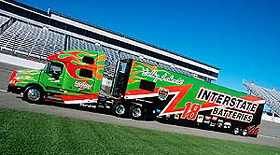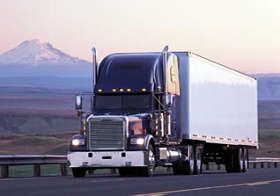Need Some Quick Clarification On The 30 Minute Break With Hazmat
Topic 8858 | Page 1
Dave, that's actually incorrect. A 30 minute break is a time that you rest. On-Duty is considered work so it does not count towards that 30 minute break.
So if you log it as On-Duty then you'll never satisfy your 8 hour rule.
For hazmat you need to log it as Sleeper Berth. This will show that you were inside your equipment. You don't want to log that break as Off-Duty because that will mean you weren't near your truck.
So log it as Sleeper Berth even if you spend that time to use the restroom.
But you definitely cannot log that as On-Duty no matter what you're hauling.
HAZMAT:
Hazardous Materials
Explosive, flammable, poisonous or otherwise potentially dangerous cargo. Large amounts of especially hazardous cargo are required to be placarded under HAZMAT regulations
Sleeper Berth:
The portion of the tractor behind the seats which acts as the "living space" for the driver. It generally contains a bed (or bunk beds), cabinets, lights, temperature control knobs, and 12 volt plugs for power.

I agree with Daniel. I haul hazmat. Some really creepy stuff sometimes but make sure to log sleeper berth if there is an issue.
Most companies issues their drivers with a release from duty form when they start driving. It covers things like bathroom breaks and 30 breaks.
And you may want to ask your company a pointed question about this. It's something you will need to know if you are questioned by the dot about your log book. One big red flag for the DOT is the lack of certain duty status'. No "off-duty" status means you never left your truck therefore you never used the bathroom.
Simply put... How are you going to explain how you used the bathroom while in the sleeper?
Just saying.
HAZMAT:
Hazardous Materials
Explosive, flammable, poisonous or otherwise potentially dangerous cargo. Large amounts of especially hazardous cargo are required to be placarded under HAZMAT regulations
Sleeper Berth:
The portion of the tractor behind the seats which acts as the "living space" for the driver. It generally contains a bed (or bunk beds), cabinets, lights, temperature control knobs, and 12 volt plugs for power.
DOT:
Department Of Transportation
A department of the federal executive branch responsible for the national highways and for railroad and airline safety. It also manages Amtrak, the national railroad system, and the Coast Guard.
State and Federal DOT Officers are responsible for commercial vehicle enforcement. "The truck police" you could call them.

Probably late to mention this, but the majority of the trucks we have, including the one I've been in, are day cabs. Very few sleeper cabs here. Maybe that's the reason...?
Either way I have no issues logging it as off duty or whatever. Just want to make sure I do it right.
Day Cab:
A tractor which does not have a sleeper berth attached to it. Normally used for local routes where drivers go home every night.

Probably late to mention this, but the majority of the trucks we have, including the one I've been in, are day cabs. Very few sleeper cabs here. Maybe that's the reason...?
Either way I have no issues logging it as off duty or whatever. Just want to make sure I do it right.
With day cabs if you even think about using Sleeper Berth you will be in for a very long day trying to explain that one to a DOT officer and a big ole fine on top of it. Lol
Day Cab:
A tractor which does not have a sleeper berth attached to it. Normally used for local routes where drivers go home every night.
Sleeper Berth:
The portion of the tractor behind the seats which acts as the "living space" for the driver. It generally contains a bed (or bunk beds), cabinets, lights, temperature control knobs, and 12 volt plugs for power.
DOT:
Department Of Transportation
A department of the federal executive branch responsible for the national highways and for railroad and airline safety. It also manages Amtrak, the national railroad system, and the Coast Guard.
State and Federal DOT Officers are responsible for commercial vehicle enforcement. "The truck police" you could call them.
New Reply:
New! Check out our help videos for a better understanding of our forum features

















Preview:








 TT On Facebook
TT On Facebook
So I started driving recently. My company hauls caustic out to paper mills as a big part of their customer base. Most loads are hazmat , 1824 or 1993 or something similar. I've heard when you are hauling hazmat, and you take your 30 minute break, if you are loaded or carrying residue (that is placarded) that you never log your break as 'off duty' and you should log it as 'on duty, not driving', since you have a responsibility for physical security of the truck, even during your 30 minutes. It goes on to say that if you have a clean tank or you are in a secure location, you can go ahead and log it as 'off duty'. I've also heard that it should be logged as 'on duty, not driving' regardless. I want to make sure I'm doing this correct and start on the right foot. I haven't found my answer in my reg book like I was hoping for. Maybe I was just having an off day, I dunno. We run logs 100% legal, as I am, I just want to make sure I'm not being taught to do something in a way that is based on old information, someone's wrong interpretation, etc... Just want to make sure I have this down right.
HAZMAT:
Hazardous Materials
Explosive, flammable, poisonous or otherwise potentially dangerous cargo. Large amounts of especially hazardous cargo are required to be placarded under HAZMAT regulations